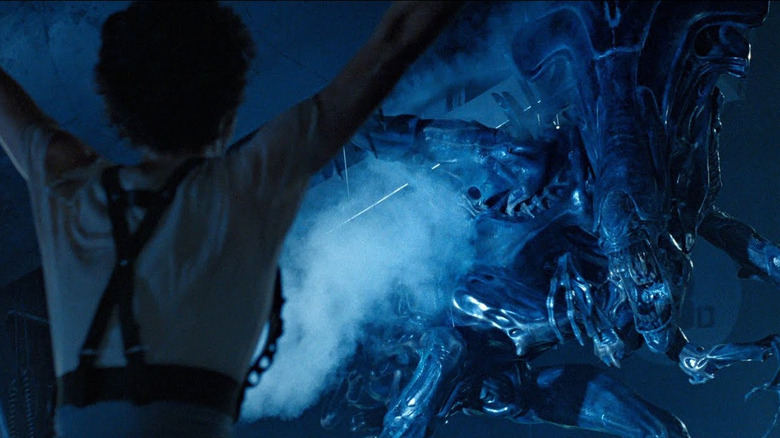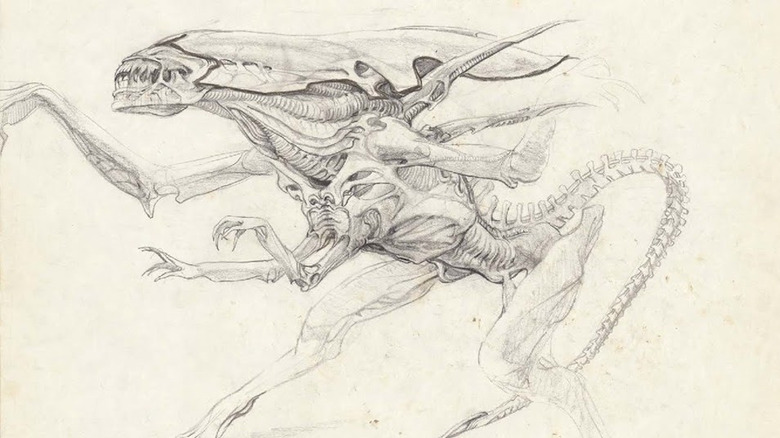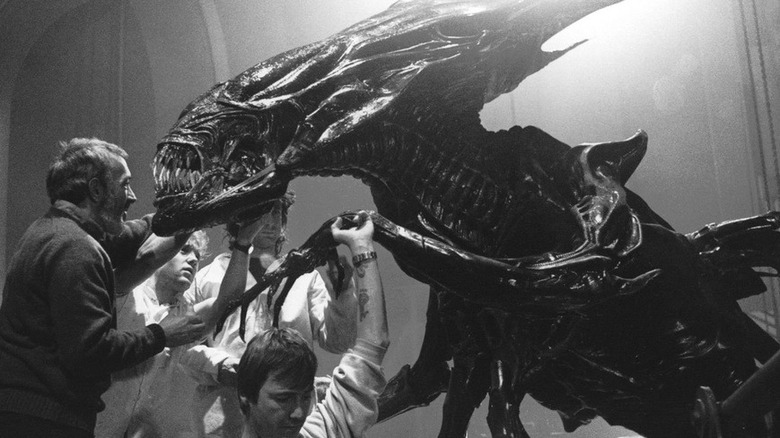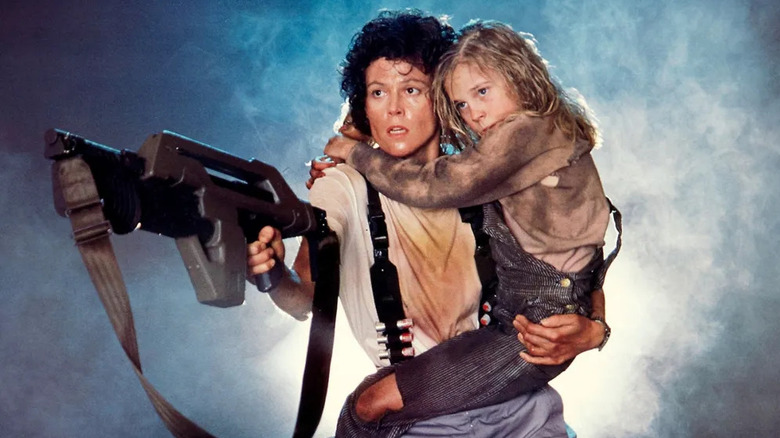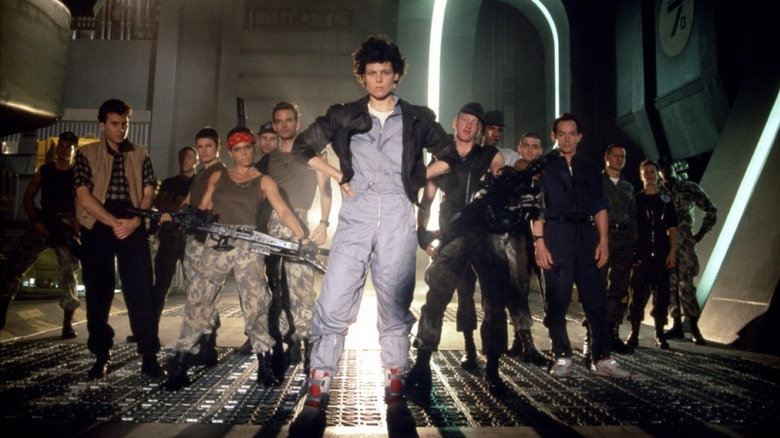Creating The Aliens Xenomorph Queen Was No Easy Task
One of the most highly-regarded sequels in its own franchise, and one of the scariest sci-fi films of all time, the "Aliens" story takes place 57 years following the events of Ridley Scott's 1979 slasher in space, "Alien," which left the Nostromo vessel a floating crime scene and Ellen Ripley (Sigourney Weaver) the last crewmember alive. The title tells you why. Now, in exhausting evergreen relevance, survivor Ripley is woken from stasis because a corporation wants her to foot the bill for destruction of the company property she barely escaped from with her life (and the life of Jonesy the stubborn cat).
The Weyland-Yutani Corporation convinces Ripley to help guide the Colonial Marines on an investigative mission after communication is lost with a human colony on the alien-occupied planet LV-426. There, she meets with a cadre of memorable characters, a young survivor of the lost colony, and, eventually, comes face-to-face with the same aggressive species that annihilated her crew. Soldier xenomorphs square off with the warriors and the result is over two hours of action and soul, reaching an apex when Ripley goes on a sudden rescue mission and finds herself in an alien nesting ground, with a slick, gargantuan Queen who is just as protective of her babies as Ripley is of hers. Her throne at LV-426 is hard-won, the result of ingenuity and a leap of faith.
In following up Ridley Scott's galactic horror picture, James Cameron (who was also penning a "Rambo" sequel at the time) had a laundry list of challenges to meet head-on. "Alien" needed to retain the corporate-critical attitude of the original, while upping the ante in a larger forum than a single ship like the Nostromo — which meant upping the monsters and the mayhem.
'Don't Stop Me Now'
As the story sprints along, Ripley meets the Queen alien unexpectedly, and they have an awkward interaction which results in Ripley setting her entire brood aflame and killing several of her soldiers. The Queen resurfaces later to voice her displeasure, and a literal power struggle ensues, with Ripley acting as a proto-Jaeger pilot in a power loader. It's a spectacular set of scenes with no CGI, just a little bit of elbow grease and madness — a potent combination that shot that movie to the number one box office spot for four weeks before David Cronenberg spread his wings with "The Fly" in August of 1986. The feature-length documentary "Superior Firepower: The Making of 'Aliens,'" made for the 2003 DVD release of "Aliens," lays out some of the obstacles that the crew had to overcome in crafting the confrontation with the Queen.
First, there was the enormous stature of the creature. Up until that point, the aliens were largely designs reused from the first film. But a Queen, like a queen bee, needed to be bigger and badder. Alien effects creator and SFX pioneer Stan Winston (who would earn an Oscar for his work on the film) worked with Cameron to craft a mock-up of the Alien Queen's towering metal skeleton to test its mobility with puppeteers. Why not just make the entire thing robotic? This was the same team that brought "The Terminator" to life, after all. In EW's oral history of the film, producer Gale Anne Hurd points to safety concerns:
"It just seemed too dangerous for Sigourney Weaver to be up against something that large, animatronic and unwieldy. What if there's a swat and it hits someone? That's going to hurt them — potentially kill them. We wanted to avoid that."
The director sketched out what he had in mind, which Stan Winston thought "nuts." But the pair collaborated to make it happen. In the documentary, which also shows off the video footage of these tests, creature effects coordinator Richard Landon elaborates:
"[Cameron and Winston] tried different approaches of how to put people in suits: facing the wrong direction so the knee joints operated backwards; two guys, back-to-back; one guy laying on his chest and one guy laying on his back, they literally had a design battle going back and forth– not to one-up each other, but to advance each other's ideas. They took points and would run with it."
The full-scale mock-up was a rush job — a 14-foot-high monster comprised of rubber foam and polypropylene garbage bags, with a pair of puppeteers inside to operate the creature's arms. Another 14 operators with control rods, hydraulics, and a crane were needed to move the whole unit, but the mock-up was a success: the Queen did not require a full-body animatronic to function. This was going to work.
'The Show Must Go On'
The Queen was finalized overseas in London, as the bulk of the movie would be shot at England's Pinewood Studios. A full treatment awaited her in the effects workshop: lifecast, sculpting, the works. Again, her size presented a challenge; puppeteers couldn't operate both the head and the arms. A hydraulic system was installed in the Queen's neck, connected to a support system with steering wheels that some lucky souls were paid to helm. Her face was another system entirely; the teeth-baring and hissing were cable-driven. With puppeteers handling the legs and arms and even more operators controlling the body (a potential total of sixteen handlers, depending on the requirements of the scene) and further supported by crane, the Queen in full glory was an incredible sight and a miracle in engineering and craftsmanship.
Cameron knew how to shoot the old girl, too. Another marvel of "Aliens" is its in-camera effects; all of those wires, cables, gimbals, and rods are unseen in the film, and it was done without digital removal in post. Recalling how Ridley Scott's (and designer H.R. Gigers') xenomorphic beasts are kept largely in the shadows in the '79 original, Cameron and Co. threw every moviemaking trick they knew at the Queen, including "lighting, and slime, and backlight, and smoke, and mist, and steam," all to keep the matriarch moderately mysterious. The Queen was ready for her close-up, all she needed was her co-stars.
'Killer Queen'
The same madness that brought James Cameron the perfect regal villain drew him to her human adversary. "I do care about the director," Sigourney Weaver told EW when asked about choosing roles. "It has to be someone who's slightly out-of-his-or-her-mind obsessed with this project." Special effects supervisor John Richardson (who would win a BAFTA Award for his work on the film the following year) recalls in "Superior Firepower" how, days away from a deadline on the power loader machine Ripley later boxes the Queen in, the "Titanic" director would get "locked-in" on "the shape of the screw head in the back corner of the heel of the boot, and we were just screaming to get the thing ready." It was a mere 3 months from start to finish, but like the production itself, the power loader arrived on schedule; and Cameron would later send Richardson a bottle of wine and a note of gratitude.
Sigourney Weaver was interested in reprising her role of Ellen Ripley upon getting Cameron's first draft of the "Aliens" script. While Cameron characterized the screenplay as "a fait accompli" in the documentary, Weaver still had considerable input regarding her character, providing the actor with a strong foundation by the time her character goes head-to-head with the other mother. By choice, Weaver did not see the mechanics of the Xenomorph Queen until it was time to shoot the climactic scene. She told EW:
"It was just so exciting to finally have a confrontation with this thing I had suspected was... somewhere. It had an almost operatic feeling because the set was so enormous and there was fire everywhere and there was this enormous creature who was, even as a puppet, was so distinctly and fiercely female. So it was kind of a great showdown and very satisfying. I don't know what [Carrie Henn's] memories of that are. She was a trooper, to stand there, you know, and take it all in."
Henn, who plays the adorable scamp (and traumatized survivor of an entire family and space colony wiped out by H.R. Giger creations) Newt in the film, definitely preferred one mom over the other. "I can't describe my relationship with her, because she's more than just a friend," she told Wired, "what you see on screen is genuinely how we feel about each other."
'A Kind of Magic'
Of course, with all of those cables and rods tucked into the creature's glistening body, it might be hard to see the Queen as anything but a puppet. "Of course, I don't think of her as a puppet [laugh], even today," Weaver said. "I made sure that I didn't know all that." Her ability to see a formidable opponent through the set mist is what Cameron credits as a lynchpin to the scene's effectiveness.
"I've always said that Sigourney Weaver made the Alien Queen alive because you believed that she believed it was there, you know? A lot of times, she's reacting to nothing. Other times, she was reacting to the full-size puppet, that was actually there. But it was her investment as an actor that made you believe the Alien Queen I think, as well as all of our tricks with lighting, and slime, and backlight, and smoke, and mist, and steam, and every other damn thing we could throw at it to kind of hide it and make it mysterious."
Not sure if anyone's told him, but it worked out. That James Cameron has a bright future ahead of him.
